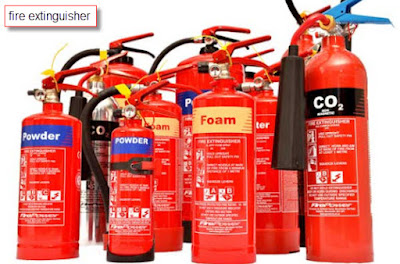There are five main types in common use today; Water, foam, powder, carbon dioxide and wet chemical. Other types of more specialist fire extinguishers include; Halon, clean agent extinguisher FE-36, and specialist powder extinguishers such as class D fire extinguishers for metal fire risks and monnex powder.
Water fire extinguishers are the most commonly used, the simplest and least expensive. They may be used to extinguish flammable solid fires such as paper, wood and most ordinary combustible materials also known as class A fires. Additives may be added to water extinguishers to boost their fire rating and their fire fighting ability, enabling smaller, lighter models to be used. Also low feeze additives can be added to protect the water from risk of freezing in cold conditions this is most commonly used for caravan parks and unheated warehouses and outbuildings.
A foam extinguisher offers class A coverage in a similar way to a water extinguisher but also offers coverage against flammable liquid fires, carrying a B rating. AFFF foam extinguishers are often specified in areas where there are no flammable liquid risks present but as a preferred medium to cover the class A risks and to meet the floor rating of the building. In offices, the spray nozzle used on most foam extinguishers, means it is safer if used accidently or inadvertently on electrical fire risks. Some foams and more recently some water extinguishers are tested to comply with a 35kva dielectric test to certify their safety if accidently used on electrical risks.
ABC dry powder fire extinguishers can be safely used on fires involving electrical equipment as well as flammable solids and liquids. They are also suitable for use on flammable gasses. As they cover various different types of fire risks, they are also known as a multi purpose extinguisher. However, although they can be used on electrical fires, the powder Mono Ammonium phosphate should not be the first choice of extinguisher to be used on sensitive electrical equipment, as it can cause damage to sensitive parts and get deep into the internal workings of small parts causing corrosion.
The first choice fire extinguisher for protecting electrical equipment is the carbon dioxide extinguisher (co2) extinguisher. The main benefit being that they are inert, clean and therefore leave no residue, working by depleting a fire of the oxygen needed to continue burning. They are also safe to use on flammable liquid fires such as petrol and oil, they are unsafe however on cooking fat fires due to their fast discharge which would disperse hot fat and risk spreading a cooking fat fire.
A wet chemical fire extinguisher is the ideal choice to fight a cooking oil or fat fire and carries the F class rating. This is a relatively new type of extinguisher which works by gently smothering and cooling the flammable cooking fat and eliminating its risk of re-igniting. They have been designed so the long lance applicator can enable the user to keep a safe distance from a fire. They can also be used safely on class A fires and have usually passed the 35kv electricity conductivity test for added user protection.
